Arafura antics (Arnhem Land)
by Don Caswell
Hunter 6
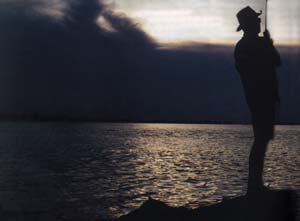
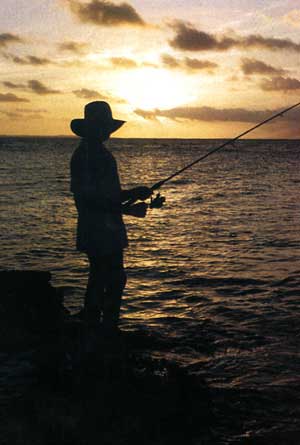
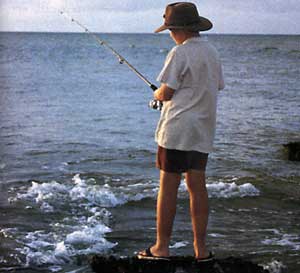
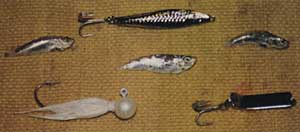
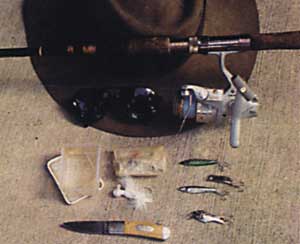
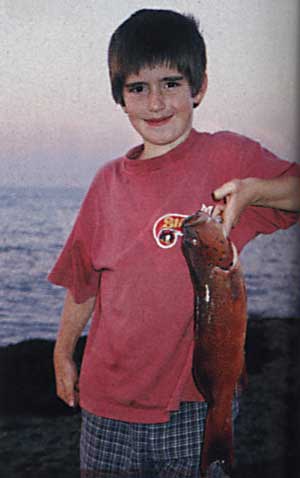
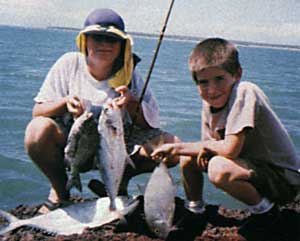 The pristine beaches of Arnhem Land offer an abundance of action for light spinning, as well as other items of interest. The waters of Arnhem Land offer excellent fishing and not least of these, although often overlooked, is light spinning. As much as I enjoy
all other forms of fishing, I find light spinning the most
entertaining. It needs little preparation or planning and can be
indulged in at whim. While some consideration of time and tide will
improve the chances of success in terms of catching fish, from a
recreational point of view it is always worthwhile.
The pristine beaches of Arnhem Land offer an abundance of action for light spinning, as well as other items of interest. The waters of Arnhem Land offer excellent fishing and not least of these, although often overlooked, is light spinning. As much as I enjoy
all other forms of fishing, I find light spinning the most
entertaining. It needs little preparation or planning and can be
indulged in at whim. While some consideration of time and tide will
improve the chances of success in terms of catching fish, from a
recreational point of view it is always worthwhile.
When the fancy takes me, I grab my trusty old Fenwick flick stick, pocket a few spare lures and a folding knife and head for the beach. If ever an excuse was needed to wander along a beautiful tropical beach, then light spinning fits the bill. In fact, I feel positively naked being at the beach without my fishing rod.
Early morning and late afternoon are more pleasant times to fish in the tropics and tend to offer better results. When I am keen to concentrate more closely on my fishing I opt for an early morning start. Generally, at that hour of the day, the only other member of the household with an inclination to accompany me is the dog.
It was not long after sun up. The water was dead calm. A distant, crawling, white speck on the deep blue Arafura Sea indicated a boat heading out to fish the reef. Big, solid, wet season clouds were already stacked high along the horizon and would, with a little luck, work themselves up for a relieving afternoon ‘monsoonal’ downpour.
I had the beach to myself, apart from Bullet, our cattle dog cross, who was busy chasing bait in the shallows. He looked wistfully about, disappointed at not having any waves or children to chase and bark at. I strolled along the water’s edge heading toward the rocky Cape Wirawawoi, a few kilometres further on in North Eastern Arnhem Land.
With long practice and an unbroken stride, I cast as I walked. Each flick of the wrist sent my Bumper Bar lure on a sparkling trajectory to shatter the morning calm of the Arafura Sea. As always, I intently scanned the waters through my Polaroids, looking for any sign of activity. Today there was another reason for close scrutiny of the water. Some days prior a crocodile had been spotted cruising along this very beach and dogs have been taken by crocs on this beach in the past.
I was having to call the dog back in every five minutes when he swam out too far. If he was unlucky enough to get eaten I would doubtlessly get the blame and would be unanimously nominated the ‘worst bastard in the universe’ by the rest of the family.
Unusually, I was also occasionally scanning the she-oaks and sand dunes behind me as well. A few hundred metres back down the beach a wandering set of deep, scuffed, imprints showed where a buffalo had wandered into the water and then back out again. Buffalo are still very much part of the scene in this country and, while generally harmless, need some respect. In the Gove area there have been a few nasty incidents with buffalo, which in one case resulted in a fatality and in another incident, severe injuries.
The risks, such as they were, did not detract from my enjoyment of the morning. Quite the opposite in fact. A bump on the retrieve prompted a halt and a few more casts in the area. The culprits were easily spotted as they chased the lure back into the shallows - northern dart. I walked on.
The dog kept a wary eye on the lure and maintained a safe distance. When he was a pup he had made the mistake of diving into the water and grabbing onto a big popper. The trebles had sunk into his gums and, given that we were camped on a remote beach many hours of hard four-wheel driving from town with no local vet anyway, it had necessitated some impromptu surgery.
Such things are best done quickly, if done at all, and the resultant operation was probably an unofficial world speed record. It was accompanied by a chorus of horrendous, blood-curdling howls from poor old Bullet that convinced the rest of the party camped nearby that he was in the jaws of a crocodile. My fishing buddy, and surgical assistant, who had restrained the rest of the dog while I firmly pinned its head, volunteered the opinion that he was glad I had never considered a vocation in either dentistry or medicine.
An early morning walk along a remote and little frequented beach is always interesting, apart from the fishing aspects. I had already inspected some interesting flotsam and jetsam washed up by the night’s high tide. In addition, I had a brief look at a fair-sized sea turtle that came up for a quick breath just ahead of me. There were great schools of mullet and garfish all peacefully feeding and meandering about. There was no sign of any predatory action though.
As I neared the Cape things started to improve. The lazy swirls of mullet were replaced by the more urgent slaps of feeding pelagics and showers of tiny silverbait. At the first opportunity I cast to such a patch of action using small metal lures that mimicked the bait. The strike came immediately. The 2.7kg line poured smoothly off my Shakespeare reel in a series of fast runs. The fight did not last long though and I soon had a hefty scad flapping wet sand in my face as I de-hooked and returned it to the sea.
During the next few minutes I caught and released a few more scad without having to move from the spot. As had often happened before, the apparent action died out, but I kept casting. Once again I was rewarded with a solid hit and a more powerful fish. This one took a bit longer to subdue and turned out to be a solid little golden trevally. He was accompanied into the beach by a few of his mates. Such schools of trevally often seem to follow feeding scad.
I killed and bled the trevally then dug into the coarse gritty coral sand to bury it in the cool wet depths of the beach. I sketched a ring around the spot with my big toe before rejoining the battle. I landed and released two more trevally. The next trevally got terminated spectacularly in a huge splash, leaving little more than the head and evidence of an ample bite radius. Not surprisingly, the rest of the trevally school swept off down the beach after the appearance of the munchies. I disinterred the buried trevally and cleaned it. The stomach was packed with tiny whitebait-like fry.
There was only half a kilometre to the point and the fishing augured well as there was continual outbreaks of feeding frenzy between myself and the Cape. My progress to the point was slowed by constant action as I caught a variety of long tom, wolf herring and barracuda. None were giants but they were all big enough to give the light gear a thorough workout before being released.
Closer to the rocks something big got in on the act and blitzed me in comprehensive fashion. Probably a golden trevally from the general performance. I hastily rerigged and got back into it.
At the Cape the low tide allowed access to the deeper water from the edge of the rock shelf. I put my catch so far into one of the deep, cool mini-caves in the rock face before venturing out to the water’s edge. This is one of my favourite spots and has yielded up a lot of good fish and fun throughout the years.
This time was no different. I was happy to put a couple of small mackerel into the rock pool beside me. Only a couple of kilos apiece, they would be excellent eating. A bigger specimen of mack snatched the lure in the last metres of the retrieve and howled off for the deeper water. The fish was no more than five metres away from me when he snatched the lure and I got a good look at it.
I was preparing for a long fight when there was a huge splash in the area of the speeding fish and the line went dead. When I wound in to re-rig, the last metre or so of line was roughed up, indicating a shark had terminated my mackerel. After re-rigging again I was rewarded with a plate-sized coral trout. That was as good a way to end the session as any, so I packed it in for the day.
Bullet and I set course for our nearby home. Once more we had provided, rather than become, lunch and in that alone, the day could be considered an unbridled success.
Locations
The Gove Peninsular is situated on the very north-eastern point of
Arnhem Land. The area is serviced by daily jet flights from both Darwin
and Cairns. Road access is via the Gove Katherine track, 700 kilometres
of dirt road that is closed during the wet. It can be done by
conventional vehicle with great care and help from 4WDs at the deeper
river crossings, but is certainly not recommended. Anyone driving on
the track, which lies within Arnhem Land, will require a permit from
the Northern Land Council. Fuel can be bought at about the halfway mark
but apart from that there is nothing else. You would be well advised to
carry at least an extra spare tyre, plenty of water and some emergency
provisions in case the drive takes more than the normal nine hours or
so.
Having arrived at Nhulunbuy, you will need additional permits if you intend to leave the road. This includes all permitted beaches and bush locations. Permits can be obtained from Dhimurru Land Management in Nhulunbuy for a modest fee. You will need to be aware of the fact that most areas are off limits. In the unlikely event that you see Aboriginal people in ceremonial dress, it would be for important cultural reasons and certainly not to impress tourists, so do not take uninvited photographs.
There are a number of fishing and diving charter boats working out of Gove. Contact with these, other tourist operators and accommodation can be found through the normal tourist guides. Tourism in the area is quite limited and pre-bookings are essential.
Tackle
Personally, I rely on a 25-year-old Fenwick flick stick of about 1.6
metres that has been rebuilt several times. I have worn out half a
dozen reels on it. I use small, quality spinning reels and spool 200+
metres of 2.7kg line. Drags must be smooth and reliable because they
get plenty of work in this application. For many years I have forsaken
wire trace and use simply a short 150mm length of 8kg mono. The
occasional bite-off more than compensates for the extra hits I believe
I get when using mono trace.
Any small, metal lure will work a treat, although my favourite lure is the Bumpa Bar No 2 size, which has only recently become available again. Jigs also work well.
